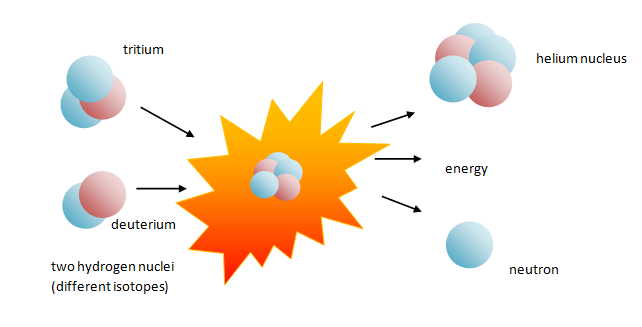Nuclear fusion occurs when two light atomic nuclei collide and form a new nucleus, releasing a large amount of energy.
For the reaction to succeed, the positively-charged nuclei have to collide at very high speed to give the short-range gravitational forces that pull nuclear particles together a chance to overcome the electrostatic forces that are trying to push the positively-charged particles apart.
This article is part of a series, including:
- What is nuclear fission?
- What is nuclear energy?
- The difference between nuclear fission and nuclear fusion
A good example of a fusion reaction is where two hydrogen nuclei collide and form a helium nucleus.
Example of nuclear fusion
In the example below the two nuclei of hydrogen are two isotopes called deuterium and tritium.
The form of hydrogen that is most abundant in nature is the one with just one proton in the nucleus – known as protium. But other, ‘heavy hydrogen,’ forms of the element, called isotopes, also exist. If you add one neutron to protium’s nucleus, you get deuterium, and if you add two, you get tritium.
Although not as common as protium, the deuterium isotope of hydrogen is found in abundance in seawater, in concentrations of about one part per 6,000 hydrogen atoms, or about 30 grams per cubic metre. Tritium however is rare in nature, as it has a short half-life of just over 12 years. It can however, be bred from lithium.
The fusion reaction that scientists are mostly working on as a way to produce energy uses one deuterium nucleus colliding with a tritium nucleus, to produce a helium nucleus, releasing a very fast neutron that can then be used to heat water or some other fluid.
To reach the sort of reaction rates that would make fusion useful as an energy source, the fuel – the deuterium and tritium mix – must be heated to over 100 million degrees Celsius. At this temperature the fuel becomes a plasma – a fourth state of matter that is hotter than a gas, so hot that all the atoms have lost their electrons to become a stream of positive nuclei and unattached electrons.
Containing plasma at such high temperatures is a big challenge – since no material exists that can do it.
Where does the energy in nuclear fusion come from?
The energy released in a nuclear fusion reaction comes from the fact that when the two hydrogen nuclei come together to form a helium nucleus, in order to stay bound they must lose a small amount of mass.
The mass ‘lost’ does not just disappear – it turns into energy according to Einstein’s famous e=mc² equation.
The energy released from converting even a tiny bit of mass is huge because c is the speed of light, a very large number indeed, and the energy (e) is equal to the tiny mass (m) times c squared.
This energy is released as the kinetic energy of the products of the reaction (in other words they get very hot), and electromagnetic radiation.
Every second our Sun turns 600 million tons of hydrogen into helium.
Fusion power – a big technological challenge
In terms of the natural resources available, fusion power offers the prospect of an almost inexhaustible supply of energy for future generations.
Yet, while every day we witness how our Sun, a self-sustaining nuclear fusion reactor, pours out massive amount of energy, here on Earth, we have yet to find a viable technology for harnessing fusion as a source of energy – there are huge scientific and engineering challenges to overcome.
At first fusion research had a narrow focus concerned with developing atomic weapons. It wasn’t until after the 1958 Atoms for Peace conference in Geneva, when information became declassified, and then Russia’s breakthrough in the 1970s with the development of the tokamak reactor, that research into nuclear fusion really took off.
Today, many countries carry out fusion research, led by the European Union, the United States, Russia and Japan, with China, Brazil, Canada, and Korea not far behind.
There some key challenges to harnessing a supply of energy from nuclear fusion – one is how to get it produce more energy than it consumes; another is how to contain the very hot ‘plasma’ of hydrogen nuclei, as there is no material capable of withstanding the temperatures required.
Currently, scientists are focusing on two experimental approaches: magnetic confinement, using strong magnetic fields, and inertial confinement, using strong lasers or particle beams, to contain the hot plasma.


